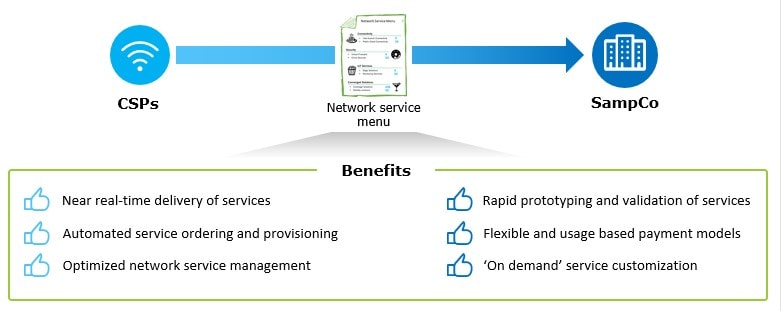The future of enterprise network architecture has been saved

Perspectives
The future of enterprise network architecture
Network orchestration strategy for communications service providers
Global demand for connectivity services is shaping the future of enterprise network architecture. With a proliferation of choices, such as cable providers and over-the-top providers, communications service providers wishing to compete are experiencing tremendous pressure to integrate new technologies as part of a systematic change and network orchestration.
Explore content
- What do customers want?
- Where to begin?
- Offering a network service menu
- Technology choices abound
- Designing for success
What do customers want?
An economy driven by information and communication technology (ICT) is accelerating the push toward a hyperconnected world. This is redefining the way we live, interact, and conduct business. The multitude of connected devices, applications, and services is a testimony to this shift.
Applications have unique enterprise network architecture requirements and are increasingly demanding custom configurations. Vehicle-to-everything (V2X) applications need ultra-low latency and high mobility while augmented and virtual reality (AR/VR) applications need higher throughput and area traffic capacity along with low latency. Depending on the need of the application, various network technologies that enable 5G may be used alone or in combination.
These technologies include:
- Mobile edge computing (MEC)
- Network function virtualization (NFV)/SDN
- Artificial intelligence (AI)
Different technologies help solve challenges in a piecemeal fashion. And with every technology outsmarting the other on performance, decision makers are often unclear on the services to choose from. There are many control points that new technologies offer, which must be carefully tuned by communications service providers (CSPs) to provide the experiences that end customers are demanding.
As if that weren't enough, most customers are expecting instant gratification. A mix and match of the enterprise network architecture requirements (e.g., storage, security, latency, performance, and reliability) and resulting combinations are critical to support diverse services and applications during a network orchestration. Equally important to customers is the freedom to test their applications in a sandbox environment to fine-tune the performance and the experience before subscribing to the service.
In such circumstances, it would be best to offer the services that a communications service provider is considering (connectivity, security solutions, and IoT offerings.) in a customizable network service menu format, enabling customers to order à la carte, according to their business needs.
As simple as it sounds, creating a consumable service menu is a labor-intensive task that requires careful planning and execution at multiple levels for the communications service provider. Starting from identifying the right services to offering the best controls for optimization, the success of the menu is closely tied to the enterprise customer experience. It's also dependent on the effective end-to-end integration of the service menu with the platform performance and the underlying technologies across ordering, fulfillment, billing, and assurance.
Where to begin?
The optimal network service menu requires certain indispensable components. These components provide convenience to the enterprise’s clients and position service providers for success.
- Right theme. Before they can offer the service menu, communications service providers should partner with enterprise clients to carefully plan the categories and the menu’s overall design.
Services can be organized into one of many themes

- Ease of discovery. The first customer touch for network services is mostly through the network service menu. Therefore, incorporating technology aids, such as chatbots that use AI to curate customer cues and suitably tailor the experience, is pivotal to the success of the service menu.
- Order to taste. Granular, application-based customization (levels of QoS, uptime guarantees, etc.) and a sandbox environment (to test the platform’s ability to meet the application’s unique requirements) enhance the value of the network service menu.
- Instant delivery. It’s critical to develop capabilities that deliver services in near real time. But it’s equally important to establish reasonable expectations with customers where real-time delivery isn’t possible.
- Rapid scalability. Rapid scalability of cloud platforms and on-demand capabilities of virtual technologies have made it possible for enterprise customers to demand, in a matter of seconds, services such as provisioning of an additional secure video delivery channel or firewall for security.
Offering a network service menu
A network service menu that displays the customizable services across a broad category of network capabilities, including mobility, connectivity, and device management, alongside the quality of service (QoS) controls and a demand-based pricing card, will create the perfect menu for future enterprise customers to choose from. The platform will enable users to quickly deploy, terminate, or update services on the fly. And it will allow enterprises to opt for the network services and service guarantees that specifically meet their application requirements.
In addition to displaying the various services offered by the CSP, the network service menu should act as a front end for the services offered by CSP, enable custom definitions of service-level agreements (SLAs) such as latency and data, and facilitate a sandbox environment where they can fine-tune applications for best performance. Customers should be able to easily browse through the menu, assisted by an intuitive, AI-powered portal, and select services based on a projected monthly cost.
Additionally, by establishing self-service as the primary method for service enhancement or change requests, CSPs can cut down on operational expenses significantly. At the same time, this capability offers CSPs strategic insights into the client’s service delivery and operational requirements, which can be directly leveraged in improving future offerings.
Network service menu benefits CSPs and enterprise customers


Technology choices abound
While CSPs are faced with an ever-expanding range of enabling technologies, a few of these are fundamental to offering a service menu to end customers.
- Virtualization through NFV and SDN helps transform traditional network functions into software-based building blocks. These provide CSPs the much-needed flexibility to programmatically create traditional network functions (routing, security, etc.) and reduce the time it takes to provision and launch new services.
- Physical infrastructure remains an integral element of the CSP infrastructure. Network automation integrates this infrastructure effectively with cloud-based solutions—enabling agility similar to the virtualized network—and is important for successful network service menu operationalization.
- Artificial intelligence-based platforms need to operate in tandem with service offerings on the menu to artfully guide the customer experience with intuitive statistical feedback. Data analytics can also predict and resolve a range of network issues by studying network data before they impact customers.
- Multi-access edge computing (MEC) adds computing resources closer to data collection points (network edge). This restricts the amount of data that needs to be shared back with cloud, relieving network bandwidth and enabling time-sensitive data processing.
- Network slicing helps segregate applications into multiple logical slices on common enterprise network architecture. These slices expose unique network characteristics to individual applications, such as end-to-end latency less than five milliseconds, and can be served to customers via the network service menu.
- 5G technology ecosystem brings together players such as CSPs, edge and public cloud providers, application platforms, infrastructure companies, etc., with meaningful business relationships and technical integration.
Designing for success
Despite being in an early adoption phase, real-life deployments with select clients clearly outline the need for careful consideration across some of the following areas:
- Scrutinizing the business case. The foremost step for any CSP developing a service menu should be to vet the business case. Designing a service offering model, developing a list of viable services, and beta-testing that model with trusted customers is crucial for the CTO and CMO.
- Evolving the right technology solution. Early adopters have leveraged multiple proprietary options to implement their unique requirements, which makes it difficult for CSPs looking for a flexible and open multivendor architecture. It will be imperative for the CIO to make the right technology choices based on the organization’s unique need to drive effective transformation.
- Investing in the process definition. One of the common traps that service providers get caught up in is focusing on technology over processes. Investment in the cycle-time analysis of service delivery and processes by the COO and process specialists will help align customer experience and SLAs with new technology capabilities.
- Managing customer experience. The responsibility to the customer doesn’t end with the delivery of the service. CSPs require carrier-grade monitoring and a rapid-response mechanism to constantly optimize the customer experience across the service life cycle and guarantee security with minimal operational disruptions.

Meeting current—and future—demand
Exponential demand for network services is a hallmark of this decade but closely intertwined are the plethora of service provider choices. Many enterprise networks are still unable to take advantage of the capabilities that a contemporary network stack makes available.
CSPs can remain relevant only by offering their customers a flexible service model that enables them to customize their applications and tailor their payouts. A network service menu is only the first step toward a customer-oriented service delivery approach that enables easy discovery of available services and the creative freedom to mix and match service options with appropriate performance guarantees—all in a self-service mode with real-time prices.

Let's talk
| Rahul Bajpai Managing Director Deloitte Consulting LLP |
Sanket Nesargi Managing Director Deloitte Consulting LLP |
| Arpan Tiwari Senior Manager Deloitte Consulting LLP |
Manish Rajendran Specialist Master Deloitte Consulting LLP |
| Kshitij Lal Senior Consultant Deloitte Consulting LLP |
Abhinandan Pandey Senior Consultant Deloitte Consulting LLP |
Recommendations
Take 5: 5G in manufacturing
Part of the Take 5 on 5G article series
Connected Edge: Converging cloud, edge computing, and advanced connectivity
Empowering next-gen applications using Connected Edge

